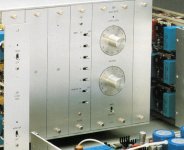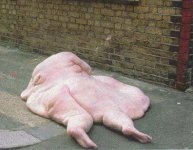Peter Daniel said:You see, that's why the amp comes with single RCA inputs. The Switching Bar is for lazy audiophiles.
Why encourage them? Ungrateful bastards will probably have a heart attack and file a lawsuit against you for making it too easy for them to switch inputs and not getting enough exercise.
I'd have thought this was funny not too long ago. But that was before the lawsuits against McDonalds.
PS: I always preferred to switch the cables than using switching controls
You're a man's man, Peter.
se
for my passive pre I used a single DPDT switch to select between two inputs.
For my second passive pre I used 2 DPDT switches.
The first one switches between my primery input and the second switch. The second switch switches between my 2 secondary inputs. So I can control 3 inputs. The primery one has only one pair of contacts in the signal path.
For my second passive pre I used 2 DPDT switches.
The first one switches between my primery input and the second switch. The second switch switches between my 2 secondary inputs. So I can control 3 inputs. The primery one has only one pair of contacts in the signal path.
ron clarke said:Wait a min, i am NOT lazy.......
But if i hook up an IR trans, dual channel, to an IR reciever and have a stepper motor for the channel selector and a dual voltage motor for volume??????
Then find a decent jukebox CD player...........hummmmmmmmmm
Trust me, you don't wanna do that. Here's what happened to the last guy who went that route.
Attachments
Re: Ugh !
Hehehe. I've no idea if it's fake or not. Doesn't look it but who knows? I just came across it tonight when I was doing a Google image search on "splat" looking for a splat GIF to use with the Fred Astaire pic I did for another thread (I opted to leave out the blood splat). This was one of the images that came up.
This is more along the lines of what I was looking for:
se
ashok said:Steve , that looks gross .
It has to be a fake (set up ) shot. Looks yuck in any case !
Hehehe. I've no idea if it's fake or not. Doesn't look it but who knows? I just came across it tonight when I was doing a Google image search on "splat" looking for a splat GIF to use with the Fred Astaire pic I did for another thread (I opted to leave out the blood splat). This was one of the images that came up.
This is more along the lines of what I was looking for:
An externally hosted image should be here but it was not working when we last tested it.
se
I would imagine that toggles could be compared to relays, which are commonly used for source switching.
I can't say I agree Peter. Those relays you highlight are sealed. They will give years of good service. Unless your toggle switches are also sealed eventually they will degrade. Just because Cello uses toggles does not mean it's good practice. I have serviced some amps from the 70's and later with toggle switches and in most cases the switches have deterioted to such an extent that replacement is the only 'fix'. Sometimes contact cleaners will work but if a good rotary selector had been used in the first place then probably no problem would have arose. Just my 2p Worth!
Peter,
I've used those switches for signal on several occasions and I always felt that they are much better than rotary switches.
Congratulations on your implementation, it looks very cute.
What I expect you to do now is a 24-position volume control with those switches.

Oh, for each channel, of course.
I've used those switches for signal on several occasions and I always felt that they are much better than rotary switches.
Congratulations on your implementation, it looks very cute.
What I expect you to do now is a 24-position volume control with those switches.
Oh, for each channel, of course.
Peter Daniel said:I also feel that those type of switches sound better than bigger rotary ones or relays. They introduce very little to the signal path and are sealed of course.
my signal selector is simply soldering: I solder or resolder my wires each time I need to switch sources. I felt that it introduces minimum distortion into the signal path and is 100% immune to outside elements.
It sounded so much better than flip or rotary type switches or relays in my listening test. the switches sounded gray, coarse and imprecise. soldering on the other hand gives very precise imagining but can be a little bit tin-can sounding but I guess it is simply because of the tinners I used.
I am also experimenting on different types of soldering irons, tinners and wires, to see if that that has any impact on sound quality, positive or negative.
millwood said:
my signal selector is simply soldering: I solder or resolder my wires each time I need to switch sources. I felt that it introduces minimum distortion into the signal path and is 100% immune to outside elements.
It sounded so much better than flip or rotary type switches or relays in my listening test. the switches sounded gray, coarse and imprecise. soldering on the other hand gives very precise imagining but can be a little bit tin-can sounding but I guess it is simply because of the tinners I used.
I am also experimenting on different types of soldering irons, tinners and wires, to see if that that has any impact on sound quality, positive or negative.
Well, all I can say: lucky you.
my signal selector is simply soldering
Coming soon on Decibel Dungeon, the housewife's guide to soldering.
Ultra-purism



I see... one of the components of your system is a soldering iron.

You can't ask a friend to change source, can you?
I'd love to have a remote-controlled soldering iron.
Then I'd do it like you.
Or maby not.
millwood said:
my signal selector is simply soldering: I solder or resolder my wires each time I need to switch sources. I felt that it introduces minimum distortion into the signal path and is 100% immune to outside elements.
It sounded so much better than flip or rotary type switches or relays in my listening test. the switches sounded gray, coarse and imprecise. soldering on the other hand gives very precise imagining but can be a little bit tin-can sounding but I guess it is simply because of the tinners I used.
I am also experimenting on different types of soldering irons, tinners and wires, to see if that that has any impact on sound quality, positive or negative.
I see... one of the components of your system is a soldering iron.

You can't ask a friend to change source, can you?
I'd love to have a remote-controlled soldering iron.
Then I'd do it like you.

Or maby not.
Ropie said:I find this method of changing sources works the best for me at the moment.
HAHAHAHAH! Good job!
Don't let PETA catch wind of that.
se
Re: Ultra-purism
I have quite a few projects going on on this subject. One of them is to use 24K gold extrusion rods or bars as a conducting element. The difficulty with it is that, aside from cost, that you need an on-site smelter for re-solder the joints each time you switch. a pain in the rear if you ask me.
However, the gold rods switch sounded, erh, brilliant, clear, rich, and generally pleasant, if not a little too yellowish.
the tin-can sound under the tinner is completely gone!
Worth every dime of yours to try it.
carlosfm said:Then I'd do it like you.
Or maby not.
I have quite a few projects going on on this subject. One of them is to use 24K gold extrusion rods or bars as a conducting element. The difficulty with it is that, aside from cost, that you need an on-site smelter for re-solder the joints each time you switch. a pain in the rear if you ask me.
However, the gold rods switch sounded, erh, brilliant, clear, rich, and generally pleasant, if not a little too yellowish.
the tin-can sound under the tinner is completely gone!
Worth every dime of yours to try it.
- Status
- This old topic is closed. If you want to reopen this topic, contact a moderator using the "Report Post" button.
- Home
- Amplifiers
- Chip Amps
- Trying to improve on an Input Chooser concept


